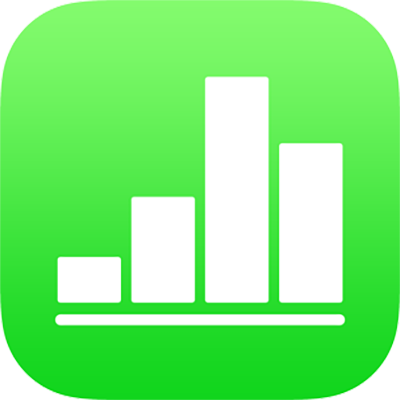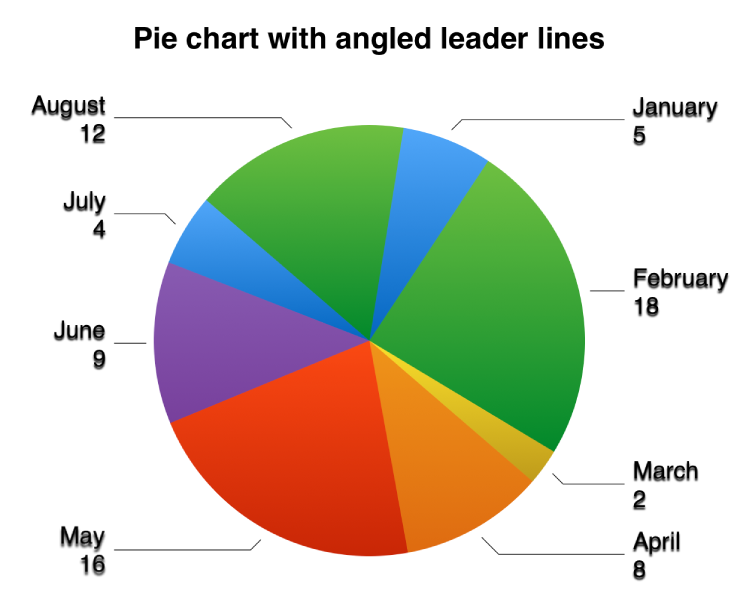
Change the look of chart text and labels in Numbers on iPhone
You can change the look of chart text by applying a different style to it, changing its font, adding a border, and more.
If you can’t edit a chart, you may need to unlock it.
Change the font, style, and size of chart text
You can change the look of all the chart text at once.
Tap the chart, then tap
 .
.Tap Style, then tap Labels.
Do any of the following:
Change the font: Tap Chart Font, then tap a font.
If you don’t see Chart Font, swipe up from the bottom of the controls.
Change the font style: Tap Chart Font, tap
 next to the font, then tap a style.
next to the font, then tap a style.Make the font smaller or larger: Tap
 .
.All text in the chart increases or decreases proportionally (by the same percentage).
Tap
 to close the controls.
to close the controls.
Edit the chart title
Charts have a placeholder title (Title) that’s hidden by default. You can show the chart title and change it.
Tap the chart, tap
 , then tap Chart.
, then tap Chart.Turn on Title.
To change the alignment of the title—so it’s on the left of the chart, for example—tap Style, then choose an alignment option.
To move the title to the center of a donut chart, tap Position, then tap Center.
To edit the title, select its text, type a new title, then tap Done.
Add and modify chart value labels
Charts have labels that show the values of specific data points. By default, chart data is displayed using the same format as the source data. For example, if the source data is formatted as a percentage, the data in the chart shows a percent symbol. You can change the chart format to show only the number, and choose where the data labels appear.
Tap the chart, then tap
 .
.Tap Style, then tap Labels.
Do any of the following:
For pie and donut charts: Turn on Values, then tap Position to choose where you want the labels to appear. To hide value labels, turn off Values.
If you tap Location, select Inside, and turn on Prevent Overlap, labels may move to avoid overlapping, and leader lines may appear to connect the labels to their wedges or segments. If you select Outside, the labels move outside the wedges or segments. To connect the labels to their wedges or segments, tap either Straight or Angled to turn on leader lines; tap None if you don’t want leader lines. With angled leader lines, the callouts align into columns, as shown below.

For scatter and bubble charts: Tap Values under Data Point Labels, then choose between Value (X) or Value (Y) values. To hide value labels, tap None.
To change the location of the label, tap Location, then tap an option.
If your bubble chart has overlapping bubbles, you can turn on Show Labels In Front to stop labels from being covered.
For other types of charts: Tap an option under Series Values to place the labels in a specific location—such as Bottom, Middle, Top, or Above. The options depend on your chart type.
To show the chart data as numbers (instead of the source data format), do one of the following:
For pie and donut charts: Tap Number Format, then tap to turn off Same as Source.
For other types of charts: Tap Value Labels, tap Number Format, then tap to turn off Same as Source.
If Same as Source is turned on, the value labels match the format of the original data in the table.
Modify axis labels
You can specify which labels appear on an axis, edit their names, and change their angle of orientation.
Tap the chart, then tap
 .
.Tap Style, then tap Labels.
Do any of the following:
Modify markings on the Value (Y) axis: Tap Value Labels under Value (Y) Axis.
Modify markings on the Category (X) axis: Tap Value Labels under Category (X) Axis.
Use the controls to make any adjustments.
If you turn on Axis Name, Numbers adds a placeholder axis name to the chart. To change it, select the axis name, then type your own.
Note: Axis options may be different for scatter and bubble charts.
To add a caption or label to a chart, see Add a caption or title to objects in Numbers on iPhone.